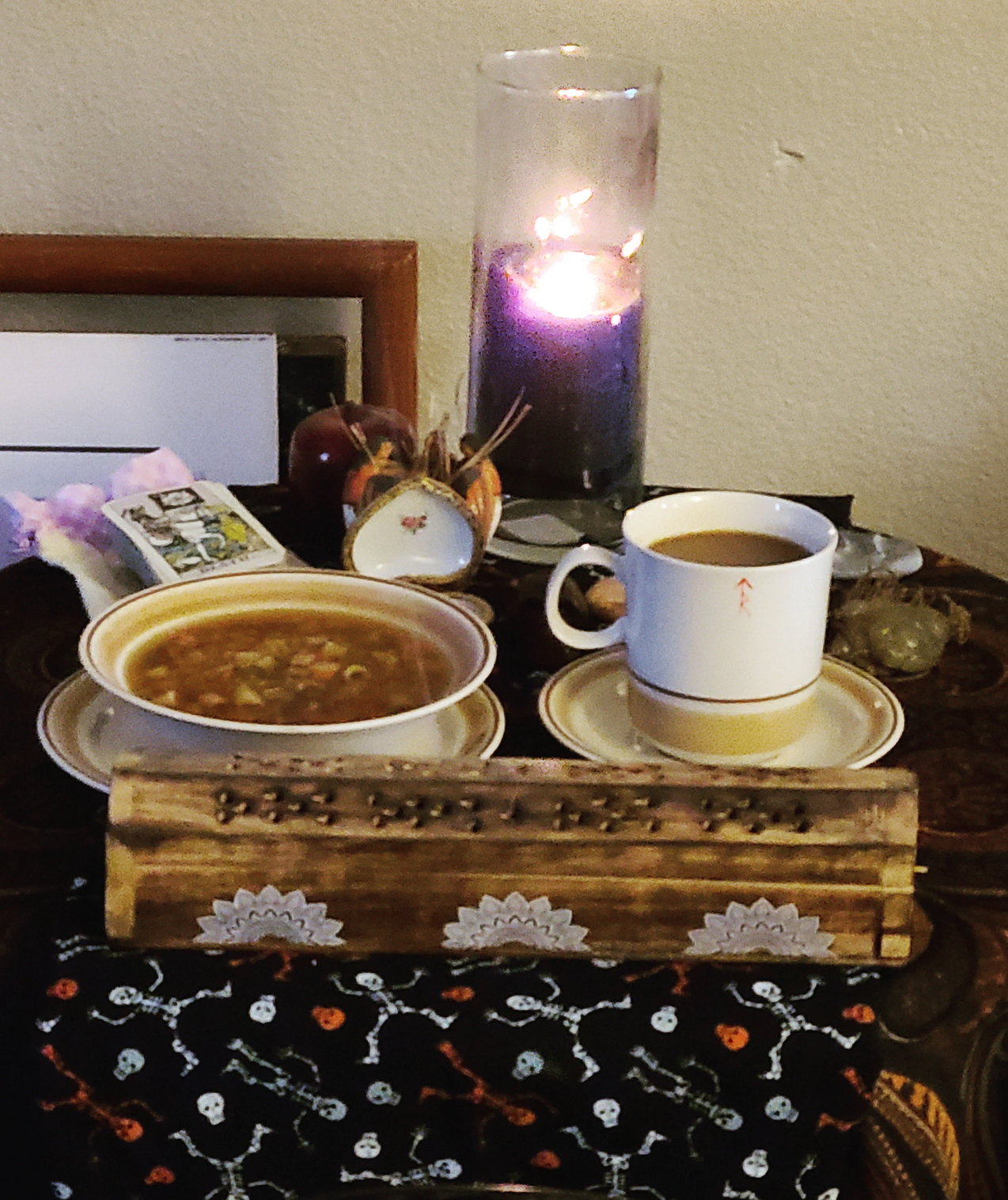Willow was a fiery redhead with a quick wit and an infectious smile. When she laughed, the whole world laughed with her. When she spoke, the whole room got quiet to listen to her words of wisdom. She was a battered and tarnished old cup, full of experience and grace, and why she ever thought a girl like me was worth the effort, I’ll never know.

Her real name was Marcy, but nobody ever called her that. To the world of Wicca and Witchcraft, she was fondly known as Grandmother Willow. I first met her at a community gathering in the autumn of 2001. It was a study group, and she was giving the lecture that week. I don’t remember now what it was she talked about, but I do remember that she greeted me with a hug and a pat on the back, like she’d known me forever. She was a powerful and independent woman who knew what she was talking about and didn’t suffer fools gladly, and she was also mischievous, slightly off-color, and a little immature at times. She was a real witch, and I wanted to be just like her.
I was eighteen then, and not nearly as grown as I thought I was. I had read every book in the Barnes and Noble’s New Age section. I knew all the Sabbats – seasonal festivals – from memory and could cast a magic circle like there was no tomorrow. There wasn’t a spell I couldn’t master in three tries or less. In my head, I was the Goddess’s gift to teenage pagans everywhere – a saavy, streetwise superwitch – and I relished the forbidden thrill of wearing a pentacle the size of a hood ornament.
Willow was fifty-four and saw right through me. Every time she saw me, she’d ask, “Are you practicing?” And I’d say, “Yes, Grandmother, I am.” And she’d give me this look that said she knew I was lying and saw no reason to dignify the fact with comment. It unsettled me. None of my showiness impressed Willow. She was old school, coven-trained, from the days when it didn’t matter whether or not the Craft was protected under the First Amendment. People could still make your life a living hell if they thought you were a devil-worshipper or some such nonsense, so a good witch was neither seen nor heard, and a great witch was such a model of Christian virtue that people would balk at the very accusation of witchcraft. Willow had been a witch for forty years, and from the very first, I wanted to prove to her that I was just as worthy of awe and respect as she was. I’m sure I made her blood pressure rise every time I opened my mouth. Still, she must have seen something in me, because she invited me to join her training coven.
There were four of us in Willow’s circle, women of varied ages who were newcomers to the community if not the faith. There was Bailona, about my age and opinionated. Wren was older, an empty-nest office professional who enjoyed learning and exploration. The other, I don’t remember her name now, was in her mid-thirties, a soft-spoken homemaker who was just discovering the Craft.
We met on Saturday afternoons at Wren’s house. After coffee and chatting, Willow would teach bring us into the living room and teach us the way she was taught: the priestess spoke and the novices listened. A coffee table became our altar, a thrift-store water goblet our chalice and a cherished statue of the Madonna our image of a kinder, gentler deity. She would open her Book of Shadows, a handwritten tome of bound vellum filled, with a lifetime of learning. The outside world fell away as the smell of incense filled the air, and I began to learn the ways of Wicca as Willow knew them.

She made each of us start at the beginning, with the Rede (An’ it harm none, do what ye will), the three faces of the Goddess (Maiden, Mother, Crone) and the eight Sabbats (Samhain, Yule, Imbolgc, Ostara, Beltaine, Midsummer, Lughnasadh, Mabon). Then came the Witch’s Pyramid (To Know, To Will, To Dare, To Keep Silent) and the Cone of Power (the shape the magic takes as it is raised and then focused toward a particular goal). It bored me, because I already knew all this, and on a couple occasions, I wondered if the old bat was going to teach us anything useful. Finally, about eight weeks into our study, Willow slapped me with something I didn’t know. The lecture had taken a sidetrack into the realm of definitions, and someone – I think Bailona – asked Willow what she meant when she talked about power. Power, Willow replied, didn’t have anything to do with how much of a mess you could make of someone’s life by throwing magic at them. My ears perked up. I was about to learn a Mystery, right from the lion’s mouth. “Power,” Willow said, “is another word for ability, which means effectiveness. A witch’s power is her ability to effectively achieve a certain end. Magic is only one half of power.” That immediately got my attention. “What’s the other half?” I asked. I was all for power in those days.
“Action,” she told me. “There is no amount of magic that can make up for the simple act of doing. There’s no such thing as an armchair priestess. All the magic in the world won’t help you if you don’t get off your ass and help yourself – and you have to get yourself in order before you can help others get themselves in order.”
I went back to the dorm that afternoon star-struck by her words. Was that what I’d been missing all along? In all my reading, had I entirely missed the point of witchcraft? I didn’t go to the next circle meeting, but the week after, I was right back with the others – a changed woman, though not by much.
Even with the enlightenment Willow’s words had brought to me, I still had the seductive image of the Hollywood witch coloring my perspective of who I ought to be. I saw the wisdom in Willow’s words, but I couldn’t change so many years of habit in one week or even two. I was always was a very dreamy, head-in-the-clouds sort of person, and while I did change for the better – less magic, more action; less whining, more adapting – I still thought I had plenty of time to goof off before I had to buckle down and grow a little maturity.
Willow’s death taught me better.
I thought she’d live forever, she was that full of life. I never expected that she’d die weak and helpless in a hospital. She’d been sick for a while with a form of anemia, trudging on despite the pain she must’ve been in. I thought she’d live through this bad turn just like she had all the others. She’d been in the hospital at least two weeks before she passed, and I’d never gone to her or even called. Two years of study, of friendship, and I still hadn’t learned the simplest lesson Willow had to offer me.
I grew up that sunny June afternoon in 2003. Reality finally struck me full in the face and I realized how wasteful I’d been with such a fleeting thing as time. How much had I really learned about living life, stretching my limits, working up to my full potential, and practicing the Craft? I was still waiting for some mystical initiation to grant me the coveted virtue of maturity. Willow’s death was her last, most treasured gift to me.
Since Grandmother Willow’s death, I have watched many people I thought were firmly entrenched in their way of life fall by the wayside. I’ve watched petty arguments and struggles for the illusion of power rip the pagan community apart. But sometimes I think Willow’s mantle is on my shoulders now. When I want to give up, I hear her telling me to keep going. When I want to magic all my problems away, I hear her chiding me that it won’t really solve anything.
When I want to get in the middle of an argument of dogma or tradition, I hear her reminding me that the true Craft will always survive in the hearts of those who practice it. And so, in Willow’s remembrance, I carry on her teachings of honor, discipline, and tradition. But for myself, I cherish the bittersweet memory of time wasted and sacrifices that can never be repaid.
Marcia Young, initiated as H. Salyx Nuit and warmly known as Grandmother Willow, died June 18, 2003, at the age of 56, in Little Rock, Arkansas. She dwells among the Mighty Dead of many covens, including Ordo Stella Maris and Circle Fey. What is remembered, lives.

